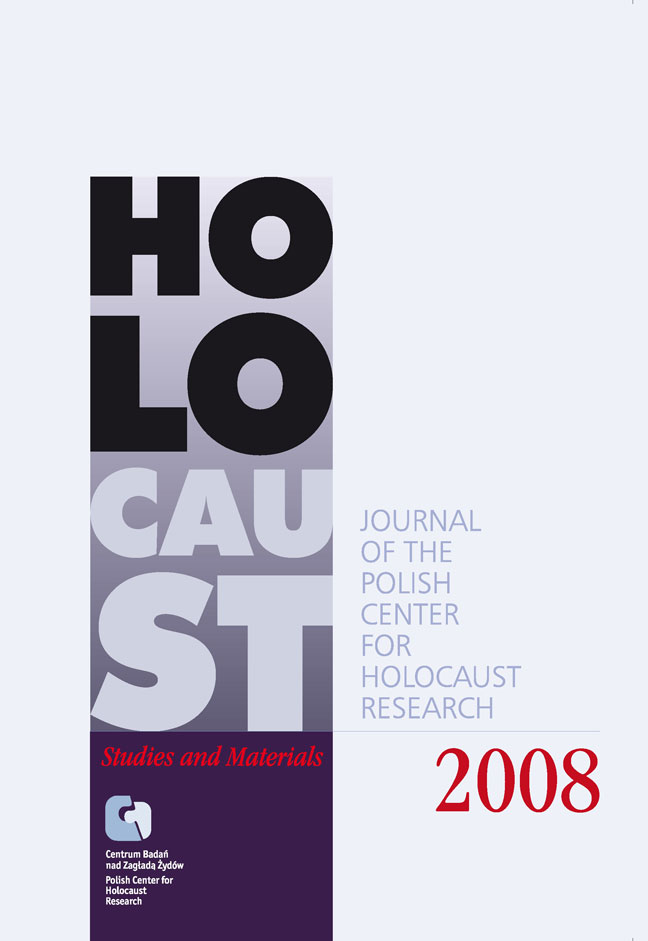Błoński’s Essay Years Later
Zagłada Żydów. Studia i Materiały, 2008, Strony: 23-30
Data zgłoszenia: 2020-09-25Data publikacji: 2008-12-01
 https://doi.org/10.32927/ZZSiM.55
https://doi.org/10.32927/ZZSiM.55
Abstrakt
The author reflects upon Jan Błoński’s essay “Biedni Polacy patrzą na getto” (Poor Poles look at the ghetto) nearly twenty years of its publication by Tygodnik Powszechny. He points at the innovative character of the depiction of Polish-Jewish issues in the moral context, outside of all the political embroilments. Błoński’s voice is unique, because it acknowledges, in the spirit of the Gospels, that analysis of Polish- -Jewish relations is a fundamental issue for the Polish society, a “homework” that needs to be done. This essay, Głowiński claims, is free from the embroilment in the dualism of the negative and positive myths regarding these relations. The author writes about reactions to this text, the letters to the editor and notes one particular voice, which he reads as an internalised nationalist ideology and the dangerous continuation of the nationalist discourse. Głowiński’s sketch concludes the post scriptum, in which the author refers to another article, published in 2006 by Gazeta Wyborcza, regarding the current historical policy, whose proponents see Błoński’s essay as a negative reference
point. The author notes that this essay constantly evokes strong emotions, and, as an expression of critical patriotism, still has its ardent opponents.
Licencja
Prawa autorskie (c) 2008 Autor & "Zagłada Żydów. Studia i Materiały"

Utwór dostępny jest na licencji Creative Commons Uznanie autorstwa 4.0 Międzynarodowe.
https://creativecommons.org/licenses/by/4.0
Inne teksty tego samego autora
- Michał Głowiński, Jan Błoński "Biedni Polacy patrzą na getto” w 20 lat później , Zagłada Żydów. Studia i Materiały: Nr 2 (2006)
- Michał Głowiński, Oczy donosiciela , Zagłada Żydów. Studia i Materiały: Nr 10 (2014)
- Michał Głowiński, Mordechaj Chaim Rumkowski – postać rzeczywista i bohater legend , Zagłada Żydów. Studia i Materiały: Nr 9 (2013)
- Michał Głowiński, Życiorys Batji Klig , Zagłada Żydów. Studia i Materiały: Nr 7 (2011)
Podobne artykuły
- Małgorzata Pakier, Prehistoria pamięci. Zagłada we wczesnym amerykańskim programie rozrywkowym , Zagłada Żydów. Studia i Materiały: Nr 7 (2011)
- Adam Sitarek, Danuta Dąbrowska – pionierka badań nad łódzkim gettem , Zagłada Żydów. Studia i Materiały: Nr 16 (2020)
- Monika Polit, Artur Kuć, Apokryf pod tytułem „Josl Rakower mówi do Boga”. Na marginesie artykułu Michała Borwicza , Zagłada Żydów. Studia i Materiały: Nr 3 (2007)
- Jerzy Mazurek, “Józek, what are you doing?” The Massacre of Jews Committed by the AK in the Village of Kosowice , Zagłada Żydów. Studia i Materiały: Nr Holocaust Studies and Materials (2013)
- Alina Skibińska, Jerzy Mazurek, „Barwy Białe” w drodze na pomoc walczącej Warszawie. Zbrodnie AK na Żydach , Zagłada Żydów. Studia i Materiały: Nr 7 (2011)
- Marta Janczewska, Dokumenty urzędowo-medyczne jako źródło do badania losu warszawskich Żydów 1939–1941 , Zagłada Żydów. Studia i Materiały: Nr 9 (2013)
- Nechama Tec, Małgorzata Melchior, O pomocy, o ratowaniu Żydów i o badaniu Zagłady – z profesor Nechamą Tec rozmawia Małgorzata Melchior , Zagłada Żydów. Studia i Materiały: Nr 4 (2008)
- Anna Bikont, „Nie trzeba było domu palić, tylko Żydów wyprowadzić i pozabijać” , Zagłada Żydów. Studia i Materiały: Nr 7 (2011)
- Bella Gutterman, Na warcie – o Cywii Lubetkin po aryjskiej stronie Warszawy i w powstaniu warszawskim , Zagłada Żydów. Studia i Materiały: Nr 8 (2012)
- Zofia Wóycicka, U „kresu pewnej moralności”: dyskusje wokół procesów więźniów funkcyjnych w Polsce 1945–1950 , Zagłada Żydów. Studia i Materiały: Nr 3 (2007)
<< < 19 20 21 22 23 24 25 26 27 28 29 30 31 32 33 34 35 36 37 38 39 40 41 42 43 44 45 46 47 48 49 50 51 52 53 54 55 56 57 58 59 60 61 62 63 64 65 66 67 68 > >>
Możesz również Rozpocznij zaawansowane wyszukiwanie podobieństw dla tego artykułu.
 English
English
 Język Polski
Język Polski








